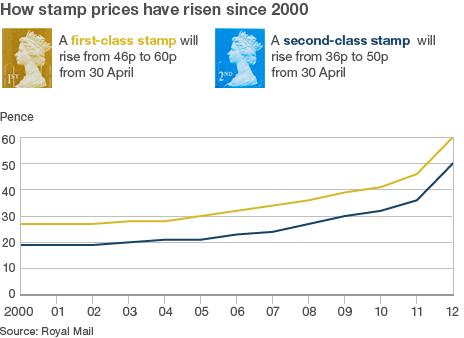Royal Mail's stamp price rises come into force
- Published
Customers at Forest Hill Road Post Office say the stamp price rise is "dreadful"
A rise in the cost of stamps has come into force after weeks of stockpiling by some consumers.
A first-class stamp now costs 60 pence, having risen from 46p, while a second-class stamp costs 50p after going up from 36p.
Royal Mail said that the price rise was necessary to keep the six-day universal postal service.
But the National Pensioners Convention (NPC) said the price rise was another blow to low-income older people.
The vast majority of pensioners still communicated with friends and family through letters, cards and the telephone - rather than email - and so they would be hit disproportionately, said Neil Duncan-Jordan, national officer for the NPC.
Rationing
Royal Mail announced on 27 March that the cost of a host of postal services would rise on 30 April.
Some shopkeepers and postmasters said the announcement prompted a rush of stamp-buying by customers, including one who said the demand was "almost like Christmas".
Royal Mail rationed retailers' purchase of stamps in April to 20% of a retailer's annual allocation. This was to prevent the retailers from gathering extra profit by bulk-buying supplies ahead of the price rise to sell later.
Sub Post Master, Nilesh Joshi says the price rise "in order to get a universal delivery service it's absolutely necessary"
The announcement of the price rises came after the regulator Ofcom lifted some price controls on Royal Mail.
It claimed the future of the universal service was at "severe risk" without relaxing controls.
Officials from Ofcom told MPs that the average UK family now spent less than 50p a week on mail services.
However, Mr Duncan-Jordan, from the National Pensioners Convention, said that older people - often with an income of less than £10,500 - needed to look at every penny they spent, even if it was a small amount.
"It means they have to choose whether to send a letter or not, or to buy stamps instead of something else," he said.
'Understanding'
Nilesh Joshi, sub-postmaster of Forest Hill Road post office in south London, said that some of his customers had bought extra stamps in the run-up to the price rise.
However, he said that the increased demand did not amount to "panic buying".
He said that some of these customers had been concerned about the price rise.
"Unfortunately, it is something that needs to be done," he said.
"Generally, when you explain the reasons behind it, they are quite understanding."
The 30% price rise in first-class stamps, and 39% rise for second-class, mark the biggest annual increase in percentage terms since 1975. Ten years ago, a first-class stamp cost 27p, and a second-class cost 19p.
Adam Scorer, of watchdog Consumer Focus, said: "Consumers will have to decide whether the increased price of stamp is going to change their posting habits.
"Consumers will have to pay more to put Royal Mail on a more sustainable footing. But the onus should not be all on consumers. Royal Mail knows that it cannot just rely on price rises to make a better return but must also deliver greater efficiencies throughout the entire business."

- Published30 April 2012
- Published28 April 2012
- Published27 April 2012
- Published25 April 2012
- Published13 April 2012
- Published2 March 2012
- Published28 February 2012